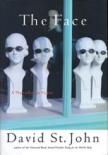Color Him Black
The Face is a sequence of 45 poems, many of them previously published in literary journals, that add up to a “novella in verse.” The very long lines of these poems, each trailing over to the next without notable pause, bespeak a poetic form leaning to prose; but does this “novella” also deliver a discernible plot? Let’s say rather that, in a postmodern way, what ties the poems together are recurrent phrases and motifs, a color code and at least one offbeat element of story.
In the early poems, the protagonist of The Face (an “I” who never receives a name) speaks often of “assembling and dissembling.” “Maybe,” he says, “I’ve been all along just this anybody/ assembling the reflections along the windows of drugstores, dress shops,/ fruit sellers,” etc. He is trying, in other words, to construct a self out of a fragmentary life and getting nowhere. After five sleepless nights he confesses, as he spruces up before the mirror, to what he sees: “It’s the new, the broken, the shattered, the Cubist me.”
The motif of mask makes visible the act of dissembling. The speaker says it is “impossible to know if I have a face anymore or simply/ the moonlit mask of a face.” The longest poem in the whole book, XXVIII, is all about masks. It reels off the varieties of mask that we all know and wear, chief among which is the face itself, the mask of flesh, the flesh masking the ghost, that is, hiding or dissembling the spirit. Yet this key poem of the sequence culminates with a welcome to some revealing presence, a mysterious Other: “Your mask. Your face. The Face. There, we’ve said it. The sweet delight.” Does the “you” refer to someone known, perhaps the woman named Toni, to whom this volume is dedicated and who is a steady and even radiant companion to the unsteady narrator? The wording, however, seems to refer to some larger, more expanded, presence.
So what about the story? This novella, with its short poetic episodes, is always on the move, without a stable center. Though we end up at the author’s home base of Los Angeles, numerous poems have their setting in Italy and France—Taormina, Capri, Rome, Paris, Senlis—casting the protagonist as an American floater in Europe.
The novella does, however, have a framework of plot. A busy and pushy woman named Infanta is producing a movie about the protagonist’s past. She even toys with doing it in reverse. For “this cinemagraphic journal of the soul,” he chooses a tough-guy version of himself, in leather jacket, drawn from the noir movies of the 1940’s. In the concluding poem, when the movie finally receives its Hollywood premiere, he runs out on it in revulsion. Outside he watches the searchlights of the theater focus on an assembling cloud, which takes on for him a distinct shape, “the white mask of a face.”
The infrequent flashes of white in this poetic sequence are a corrective to the dominant black. In an oceanside moment, for example, above “the darkness situated in the trees,” the speaker sees “white egrets like dashes...rising over the estuary.” But throughout most of the pages, black is the color that dogs the main character. As a child, when allowed to choose the colors of his room in a new house, he baffles his parents by choosing black. He reaches his nadir of self-revulsion in Poem XXX, in a theme park called “Edge World,” where he chooses a ride called “The Abyss” into a black chasm. While strapped in a kind of bungee jumper’s harness, he is pushed over a brink into the chasm, to hurtle toward scavenger animals below. He watches his own moments of humiliation projected on a canyon wall as on “one big movie screen.” This and the following poem dump us in a psychological and moral sinkhole not unlike Fellini’s “La Dolce Vita,” to which the speaker alludes two poems later. In the film, the poet, like Fellini who ends his display of social impurities with a moment of pure innocence, relives the innocent birth of his daughter, Vivienne.
Underlying The Face is a desire to recover lost faith. The author, an admired U.S. poet who teaches at the University of Southern California, enacts this search in a fine Easter poem, XX, about walking the Stations of the Cross at St. Andrew’s in Valyermo, the Benedictine monastery near Los Angeles. In the final poem, the protagonist, who has watched the klieg lights of the theater fix on “the face gathering itself along the sky,” exclaims: “It is the face I’ve been certain/ could reflect both the nothingness & faith; The Face I know/ I know & have always known.../ the face of vision, & the sweet delight.”
This article also appeared in print, under the headline “Color Him Black,” in the May 10, 2004, issue.








